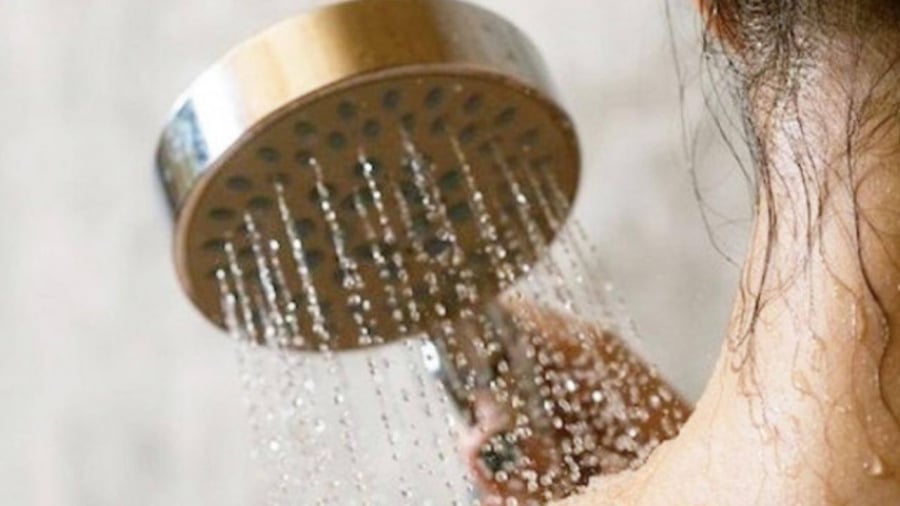Bathing and shampooing are daily rituals that not only cleanse the body but also play a crucial role in maintaining health and caring for our hair. While it is common to bathe and shampoo simultaneously, the question arises: which should come first?
Should we bathe or shampoo first for optimal results?
Traditional wisdom holds that when entering the bathroom, one should first wet their feet, take a mouthful of water, and then vigorously splash water on their chest and back. This practice, known as “dội nước,” is believed to prepare the body for the change in temperature that bathing entails, reducing the risk of stroke and preventing colds. After this initial ritual, the mouthful of water is spat out, and the bather proceeds to wash their body, concluding with shampooing their hair.

According to modern medical professionals, the proper sequence is to begin by wetting the arms and legs, allowing the body to adjust to the water temperature, followed by a shower, and finally, shampooing the hair. This approach prevents sudden changes in body temperature, which can affect blood circulation in the brain.
Bathing in the wrong order, particularly pouring water suddenly from the head down, can lead to unpredictable changes in blood circulation, potentially resulting in strokes or colds. This risk is heightened in cold weather when using hot water, as the sudden change in temperature can cause blood vessels to rupture. Therefore, it is advisable to lower your body temperature first, either after exercise or by removing warm clothing, and then start by wetting your lower body before progressing to a full-body wash and finally shampooing your hair. If you wish to use a showerhead, it is recommended to do so at the very end, pouring water directly from the head down.
How to properly apply shampoo and conditioner
Shampoo and conditioner are essential components of our bathing routine, but they are often misused. Applying shampoo directly to the hair can leave it coated in chemicals, leading to tangles and dryness. Shampoo is intended to cleanse the scalp and treat dandruff, so it should be massaged into the scalp and then rinsed, allowing it to run through the hair.
Conditioner, on the other hand, is designed to moisturize the hair, and its sticky nature can lead to dandruff if applied to the scalp. Therefore, conditioner should only be applied to the hair, avoiding the scalp.

The pros and cons of frequent body wash use
Body washes and soaps are designed to cleanse the skin, but choosing the wrong type can lead to clogged pores or dry skin. It is essential to select a product that suits your skin type, and if it doesn’t, it is advisable to switch to a different one. While body washes can be used daily, it is recommended to limit their use to once a day, especially for those with skin conditions.
Additional notes for a healthy bathing routine
- Avoid bathing on an empty stomach, as it may cause dizziness due to low blood sugar levels.
- Similarly, refrain from bathing immediately after a large meal, as it can lead to stomach discomfort. It is best to wait at least an hour after eating before bathing.
- Do not bathe when you are sweating profusely, as it can lead to a condition known as “phong hàn.” Instead, wait for at least 30 minutes to allow your body to cool down and return to its normal temperature.
- Bathing while intoxicated can exacerbate dizziness and increase the risk of stroke.
- In the morning, wait at least 30 minutes after waking up before bathing, as your body is still adjusting to the new day.
- Bathing after 10 pm can disrupt your circulatory system and lead to death. Therefore, it is advisable to avoid late-night baths.
- When feeling extremely fatigued, ill, or running a high fever, opt for a quick rinse or sponge bath instead of a full bath.
What is the ideal water temperature for bathing?
While hot water can provide a soothing experience and alleviate pain, it can also strip the skin and hair of their natural oils. Therefore, regardless of the season, it is best to avoid extremely hot or cold water. Both extremes can be detrimental to your health, with cold water causing cardiovascular issues and hot water damaging the skin and hair. The optimal water temperature for bathing is between 38 and 44 degrees Celsius, which effectively cleanses the skin and hair while preserving their natural oils.
Additionally, ensure that your bathroom is well-ventilated to prevent a buildup of harmful gases, especially if you have a small bathroom or are in poor health. Keep bathing sessions brief, ideally between 7 and 10 minutes, with shampooing taking no more than 5 to 7 minutes. After bathing, thoroughly dry off, and avoid immediate exposure to fans or air conditioning. Allow your hair to air dry before going to bed.






































